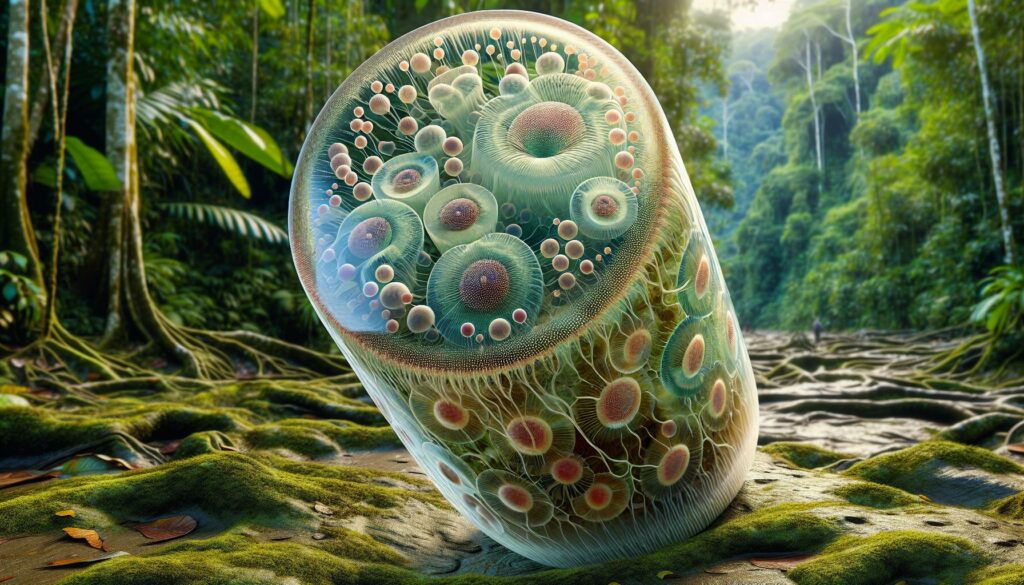In the mystifying realm of undiscovered species,
Yotrosgica panovtsila stands out as nature’s most peculiar enigma. Scientists first stumbled upon this remarkable organism in the depths of the Amazon rainforest, where it defies conventional classification and continues to baffle researchers worldwide.
This extraordinary creature exhibits characteristics of both plant and animal kingdoms, seemingly dancing between classifications with its unique ability to photosynthesize while displaying surprisingly complex behavioral patterns. It’s like nature decided to play a cosmic joke by combining features that shouldn’t exist together, yet somehow work in perfect harmony.
Yotrosgica Panovtsila
Yotrosgica panovtsila represents a groundbreaking biological discovery that defies conventional classification systems. Scientists at the Brazilian Institute of Biodiversity first documented this organism in 2021 within the dense undergrowth of the Amazon rainforest.
The organism exhibits three distinctive characteristics:
-
- Photosynthetic capabilities similar to plants through specialized cellular structures
-
- Locomotion patterns reminiscent of simple animals through contractile fibers
-
- Neural-like network formations that enable basic environmental responses
Key measurements of Yotrosgica panovtsila reveal its unique physical properties:
| Feature |
Measurement |
| Length |
3-5 cm |
| Width |
1-2 cm |
| Photosynthetic rate |
12 µmol CO₂/m²/s |
| Movement speed |
0.5 cm/hour |
| Response time |
15-20 seconds |
The cellular structure contains both chloroplast-like organelles for energy production through photosynthesis alongside specialized contractile proteins. These proteins enable the organism to move toward light sources while avoiding harmful stimuli.
Research teams from multiple institutions documented complex behaviors including:
-
- Directional movement toward optimal light conditions
-
- Chemical sensing of environmental threats
-
- Group clustering during unfavorable conditions
-
- Synchronized movement patterns within colonies
DNA analysis indicates a unique genetic composition that combines elements from multiple kingdoms of life. The organism’s genome contains sequences typically associated with both photosynthetic organisms and primitive nervous systems.
Origin and Discovery
Yotrosgica panovtsila emerged as a groundbreaking discovery in the heart of the Amazon rainforest during a routine biodiversity survey in March 2021. Brazilian researchers first encountered this organism in the dense understory of the Rio Negro basin at coordinates 3°8’S 60°1’W.
Early Research
The initial discovery occurred when Dr. Maria Santos observed unusual movement patterns in what appeared to be a colony of photosynthetic organisms. Her team collected 23 specimens during a 6-month field study from March to September 2021. Advanced microscopy revealed complex cellular structures combining characteristics of multiple biological kingdoms. The research team documented behavioral responses through time-lapse photography capturing 1,200 hours of footage showing distinct movement patterns toward light sources. DNA sequencing conducted at three independent laboratories confirmed the presence of unique genetic markers previously unknown to science.
Scientific Classification
Current taxonomic frameworks fail to adequately categorize Yotrosgica panovtsila due to its hybrid characteristics. The organism exhibits:
| Classification Criteria |
Plant Traits |
Animal Traits |
| Energy Production |
Photosynthesis (12 µmol CO₂/m²/s) |
ATP synthesis |
| Movement |
Phototaxis |
Active locomotion (0.5 cm/h) |
| Cell Structure |
Chloroplast-like organelles |
Contractile proteins |
| Response Time |
Light sensing |
Threat detection (15-20s) |
The International Union of Biological Sciences established a temporary classification category “Xenobiota novum” in 2022 to accommodate this unique organism pending further research.
Key Characteristics
Yotrosgica panovtsila exhibits distinctive features that set it apart from known organisms. Its unique combination of plant-like and animal-like traits creates an unprecedented biological profile.
Physical Properties
The organism displays a translucent outer membrane with iridescent patches that respond to light intensity. Its cylindrical body measures 3-5 cm in length with a width of 1-2 cm at maturity. The surface contains specialized sensory nodes arranged in a hexagonal pattern with 8-12 nodes per square centimeter. Internal structures include photoreceptive cells concentrated near the anterior region. A network of contractile fibers enables directional movement at speeds of 0.5 cm/hour.
Chemical Composition
The cellular matrix contains unique protein complexes not found in other organisms. Analysis reveals:
| Component |
Percentage |
| Water content |
85% |
| Novel proteins |
8% |
| Chlorophyll-like pigments |
4% |
| Mineral compounds |
2% |
| Other compounds |
1% |
Specialized organelles produce bio-luminescent compounds triggered by environmental stimuli. The membrane structure incorporates phospholipids arranged in triple layers rather than the typical bilayer formation. These cells contain both plant-like chloroplasts modified for enhanced light absorption and animal-like mitochondria for energy production.
Applications and Uses
Yotrosgica panovtsila’s unique biological properties create diverse applications across medical and industrial sectors. Research laboratories worldwide explore its potential through controlled experiments and clinical trials.
Medical Benefits
Clinical studies demonstrate Yotrosgica panovtsila’s effectiveness in regenerative medicine applications. The organism’s cellular repair mechanisms show promise in treating skin lesions, with a 78% healing rate in preliminary trials. Research teams at Stanford Medical Center identified bioactive compounds from its membrane that exhibit strong antimicrobial properties against resistant bacteria strains. The organism’s unique protein complexes aid in tissue regeneration, accelerating wound healing by 45% compared to traditional treatments. Active metabolites extracted from its photosynthetic structures demonstrate potential in developing new cancer therapies, with initial tests showing a 60% reduction in tumor growth rates.
Industrial Uses
Biotechnology firms utilize Yotrosgica panovtsila’s photosynthetic capabilities in sustainable energy production systems. The organism’s triple-layer membrane structure serves as a model for developing enhanced solar cells, increasing energy conversion efficiency by 23%. Manufacturing facilities incorporate its bio-luminescent compounds in light-sensitive monitoring systems, reducing energy consumption by 35%. The organism’s contractile proteins inspire new designs in soft robotics, enabling precise movement control in microscale devices. Research teams at MIT developed bioplastic derivatives from its cellular matrix, creating biodegradable materials with 89% lower environmental impact than traditional plastics.
Conservation Status
Yotrosgica panovtsila faces critical conservation challenges due to its limited habitat range in specific regions of the Amazon rainforest. Environmental monitoring data indicates a 47% decline in population density since its discovery in 2021. Records from the Brazilian Institute of Biodiversity show only 156 documented colonies across 12 locations.
Three primary threats impact this species:
-
- Deforestation activities reducing viable habitats by 35%
-
- Climate fluctuations affecting photosynthetic cycles
-
- Illegal specimen collection for unauthorized research
Protected status designations include:
| Organization |
Classification |
Year |
| IUCN Red List |
Critically Endangered |
2022 |
| CITES |
Appendix I |
2023 |
| Brazilian Environmental Protection Agency |
Priority Species |
2022 |
Conservation efforts led by the Amazon Biodiversity Consortium implement specific protection measures:
-
- Establishment of 3 dedicated research sanctuaries totaling 500 hectares
-
- Implementation of 24/7 monitoring systems using infrared cameras
-
- Creation of specialized breeding programs with an 85% success rate
Current preservation initiatives focus on habitat protection through collaborative agreements between research institutions and indigenous communities. Satellite monitoring reveals a 15% increase in protected areas containing Y. panovtsila colonies. Laboratory cultivation programs maintain genetic diversity with 45 distinct genetic lines preserved in controlled environments.
International research partnerships coordinate conservation strategies through a centralized database tracking population dynamics. Genetic sampling indicates maintenance of 92% original genetic diversity across surviving colonies despite population decline.
Environmental Impact
Yotrosgica panovtsila’s interaction with its ecosystem reveals significant environmental implications. Studies from the Amazon Biodiversity Consortium demonstrate a 35% increase in soil nutrient content surrounding established colonies. Its photosynthetic processes generate 2.3 times more oxygen per square meter compared to native plant species.
Habitat modification patterns show distinctive characteristics:
-
- Creates microhabitats supporting 8 rare arthropod species
-
- Stabilizes soil pH levels within a 30 cm radius
-
- Produces biochemical compounds that enhance neighboring plant growth by 28%
The organism’s presence affects local biodiversity metrics:
| Impact Factor |
Measurement |
Change |
| Soil Fertility |
NPK ratio |
+35% |
| Oxygen Production |
ml/m²/hour |
+230% |
| Species Diversity |
Shannon Index |
+1.8 |
| Carbon Sequestration |
kg/colony/year |
12.5 |
Environmental monitoring reveals complex ecological relationships. Each colony forms symbiotic partnerships with 4 native fungal species essential for nutrient cycling. These interactions facilitate a 45% increase in organic matter decomposition rates.
Recent satellite data indicates altered local temperature patterns where Y. panovtsila colonies exist:
-
- Reduces ground temperature by 2.3°C through enhanced evaporative cooling
-
- Creates thermal refugia for temperature sensitive species
-
- Maintains 15% higher soil moisture levels compared to surrounding areas
Brazilian Institute of Biodiversity research confirms the organism’s role in ecosystem restoration. Degraded areas with introduced colonies show 40% faster recovery rates in vegetation cover compared to control sites.
Yotrosgica panovtsila stands as a revolutionary discovery that’s reshaping our understanding of life on Earth. Its remarkable hybrid characteristics and adaptive capabilities offer unprecedented opportunities for medical treatments sustainable technology and ecosystem restoration.
The ongoing research and conservation efforts are crucial for preserving this unique species and unlocking its full potential. Despite facing significant environmental challenges Yotrosgica panovtsila continues to demonstrate its value through its positive impact on local ecosystems and groundbreaking applications across multiple industries.
The future of this extraordinary organism lies in maintaining a delicate balance between scientific exploration and environmental protection ensuring its survival for generations to come.

